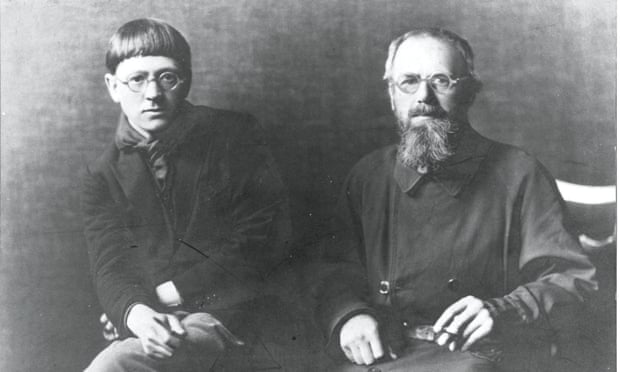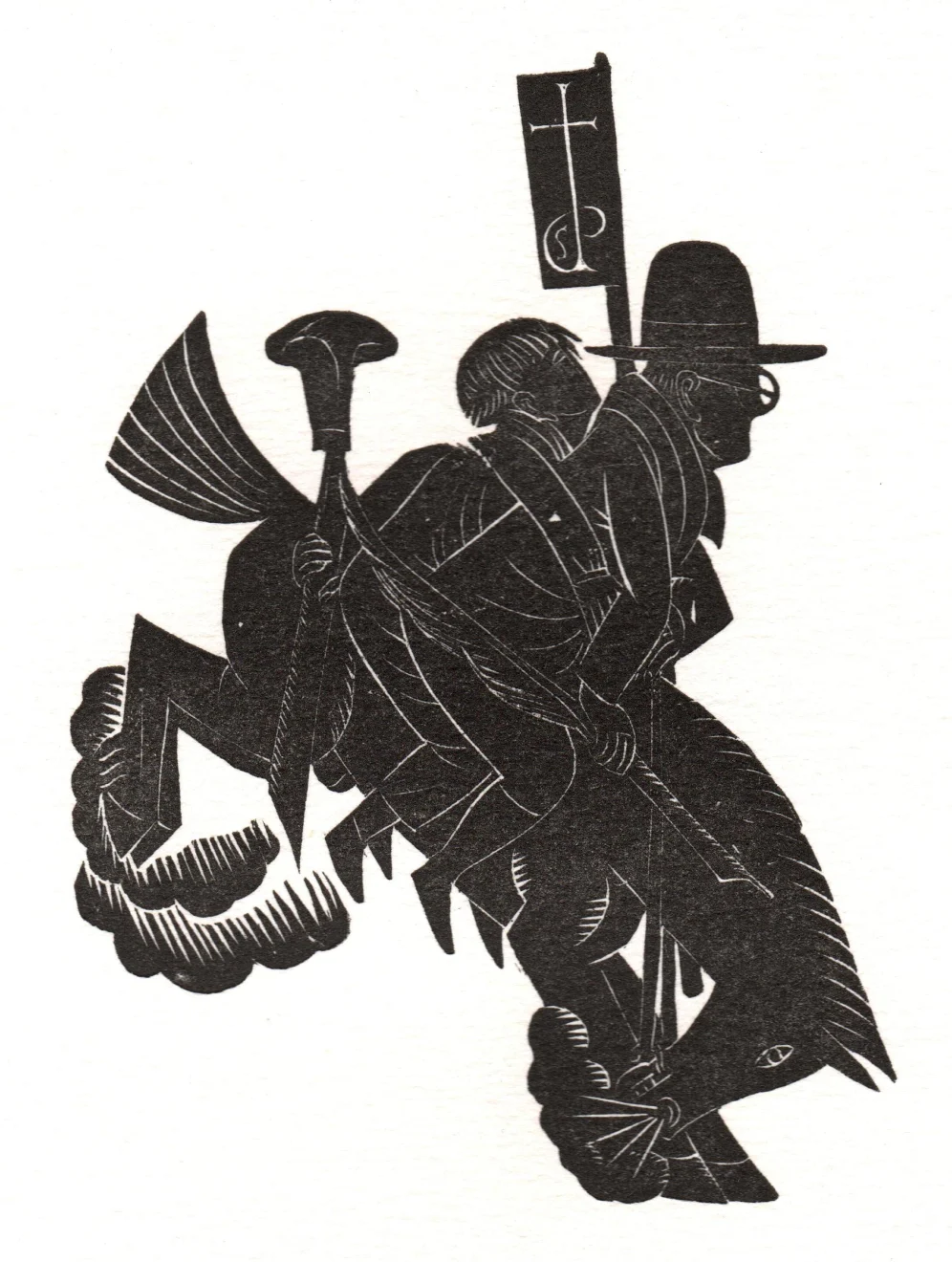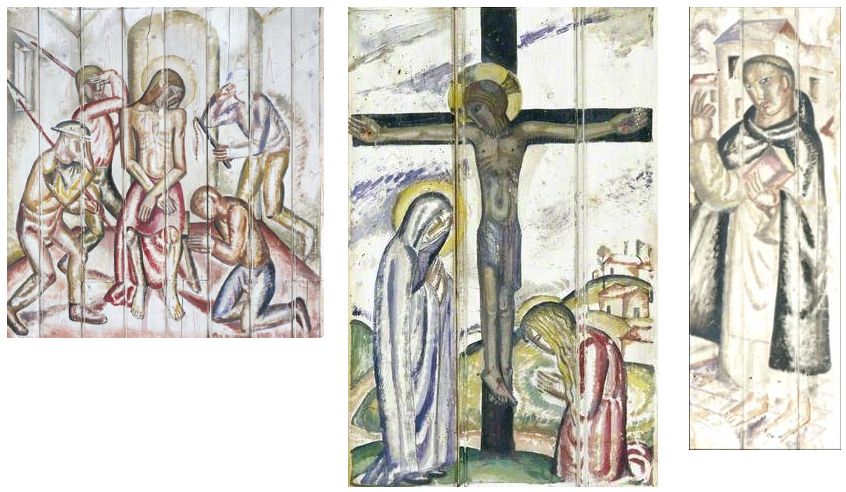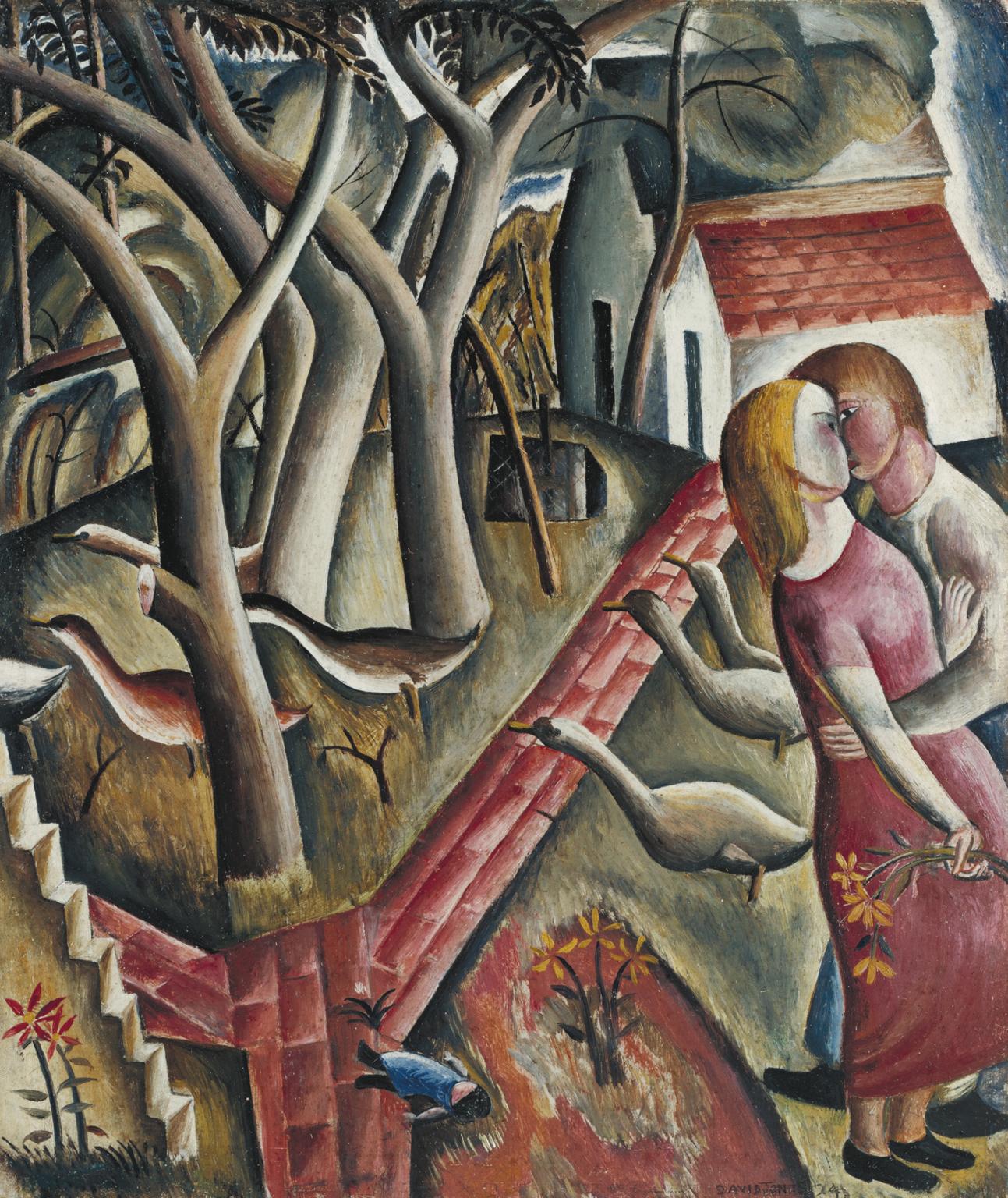- Born 1895, died 1974
- Postulant of the Guild 1924 – 1925
- At the Guild, assistant to George Maxwell – letterer, engraver, wood-carver; later – artist, poet.
Table of Contents
Life
Early life and World War I
Other that Eric Gill, there is little doubt that the most famous artist to work at the Guild was the painter-poet David Jones. Jones was born on 1 November 1895 in Brockley, Kent, now a suburb of South East London. His father, James Jones, had been born in Flintshire in north Wales, to a Welsh-speaking family but was discouraged from speaking Welsh by his father.
David Jones exhibited artistic promise at an early age, even entering his drawings into exhibitions of children’s artwork. He wrote that from the age of six he knew that he would devote his life to art. In 1909, at fourteen, he persuaded his parents to allow him to abandon traditional education for art school and entered the Camberwell Art School. There he studied under A.S. Hartrick, who had worked with Van Gogh and Gauguin, Reginald Savage and Herbert Cole, and who introduced him to the work of the Impressionists and Pre-Raphaelites. At Camberwell, in addition to his art studies, Jones also developed his knowledge of literature.

With the outbreak of the First World War, Jones enlisted with the Royal Welch Fusiliers and served on the Western Front from 1915 to 1918 with the 38th (Welsh) Division. His experiences in the trenches were to prove important in his later painting and poetry, especially his memories of the fighting at Mametz Wood.
In 1919, he won a Government grant to study again at Camberwell Art School. After Camberwell, he followed its headmaster, Walter Bayes, to the Westminster School of Art in central London, where he studied under Bayes and Bernard Meninsky. The school was close to Westminster Cathedral, which Jones often visited to participate in Mass and to view Stations of the Cross by Gill with whom he was soon to make contact.
Ditchling

On 29 January 1921, Jones came to Ditchling with a fellow student to meet with Gill. He returned for the week-end of 19 / 20 July and again for two weeks in early August. He was particularly attracted by the religious element of the Guild’s life, with its strong monastic element, and was received into the Catholic Church by Gill associate, Father John O’Connor (GK Chesterton’s model for Father Brown) on 7 September 1921. Jones moved to Ditchling Common on a permanent basis in November 1921, taking on both the craft and the religious aspects of Guild life. Initially he lodged with the Gills at Hopkin’s Crank, before moving with several other Gill acolytes into a converted cowshed, now known as Woodbarton Cottage, in the Spring of 1922.
Initially he was set to work as an apprentice of George Maxwell’s in the carpentry workshop but showed little aptitude for carpentry. The basic skills of working with wood however were to prove valuable as he became an adept wood engraver and carver. In particular, his skill as an engraver was in demand by Hilary Pepler for the St Dominic’s Press as he produced many block for use it its publications. His time in the workshop is memorialised in the three paintings he left on the walls of the small adjacent room which came to be George Maxwell’s office. In time, these painting were moved to the chapel and later sold to the National Museum of Wales. He also absorbed the Guild’s interest in lettering, which was reflected in the many inscriptions to be found in Guild workshops and homes.
Jones became fully committed to the life and ideas of the Guild and so was enrolled a Dominican Tertiary in 1923. He also developed a romantic interest in Gill’s daughter, Petra, and they became engaged in April 1924, a move which the normally controlling Gill surprisingly gave his blessing. Also in April 1924, Jones became a Postulant of the Guild, and it seemed his future was settled. That was not to be however – in truth his commitment to the Guild was closely connected to Gill himself and when Gill left for Capel-y-Finn in July 1924, Jones left the following month. His engagement to Petra was not to last either, this was in all likelihood the closest he came to being a lover in his life.
Authorities on Jones’ life are agreed that the Ditchling period was key to his artistic and spiritual development, Rowan Williams linked these two aspects in speculating that he was attracted to Roman Catholicism by the emphasis on the transformation power of sacramental life, something that Williams believed Jones saw in Art as well; the way in which the artist could transform base materials into something profound and life affirming. David Shiel sees the Ditchling years as a time when, partly due to his conversion, his entire way of being underwent a radical transformation, resulting in his ‘gradual reorientation of himself as a man and an artist’. It certainly seems that his experimentalism with different creative forms placed him in a position where he could discover the mature style which he was very soon to develop.
Post-Ditchling
After leaving Ditchling, Jones returned to London often visiting Gill at Capel-y-ffin and the Benedictines at Caldey Island, near Tenby, and in the same year produced illustrations for Gulliver’s Travels for the Golden Cockerel Press.
In 1927 Jones returned to live full-time with his parents at Brockley, although he continued to move between Capel and Caldey, as well as spending time on the coast at Portslade near Hove. He was painting prolifically during this period, and exhibited seascapes and drawings of Wales at the St George’s gallery. He also joined the Society of Wood Engravers. The following year he visited Salies-de-Béarn, in France with the Gills. In 1929, he exhibited at the Goupil gallery, including watercolour landscapes of France. From 1928 to 1935 he was a member of the artistically innovative 7 and 5 Society, becoming well acquainted with Ben and Winifred Nicholson, Jim Ede and many of the artists and collectors that were associated with the group.
In 1932 the underlying stresses and memories from his time in trenches, and which were revisited in the course of writing and creating the first draft of his modernist epic poem of the First World War, In Parenthesis, took a heavy toll and Jones suffered a severe nervous breakdown which delayed completion of the poem and prevented him from painting. Jones’s works however, were still in demand and were shown at Chicago in 1933, the Venice Biennale in 1934 and the World’s Fair, New York, in 1939. Meanwhile, in 1937 Faber published In Parenthesis; it was hailed by TS Elliot as a ‘work of genius’ and described by W.H. Auden as “The greatest book about the First World War”. It won the Hawthornden Prize in 1938, at the time the only important British literary award.
Controversially in the 1930’s Jones did privately express a measure of sympathy for German Fascism, seemingly attracted by its apparent opposition to international finance, perhaps imagining that a different world order was possible outside the structures of capitalism and Marxism. He was however, truly horrified by the persecution of the Jews in Germany and came to admit that he had simply been wrong in his assessment.
Jones continued as a prolific painter and considerable recognition followed in 1944 when an exhibition of his art work toured Britain. Sadly though, in 1947, he suffered a second nervous breakdown while staying at Cockley Moor, and he underwent treatment in a nursing home near Harrow, but he left the nursing home stronger in body and spirit – recovering through therapy in which he was encouraged to paint and draw as part of the healing process.

In 1952 Jones published a second epic poem, The Anathemata, a dramatic-symbolic anatomy of Western culture. In 1954 an Arts Council exhibition of his work toured Britain, visiting Aberystwyth, Cardiff, Swansea, Edinburgh and the Tate Gallery in London. In 1974, he published The Sleeping Lord, a collection of short and mid-length poems.
He had been frail for at least a decade before he died in Harrow, Middlesex, in 1974, aged 78. He was buried in Ladywell and Brockley Cemetery with his parents. The tomb’s headstone was carved by Eric Gill and there is a circular stone on his grave carved by Gill’s nephew John Skelton. Jones is also memorialised as a War Poet in Westminster Abbey.

Guild related paintings
From the carpentry workshop office walls:

Painted on Woodbarton Cottage wall:

Garden at Hopkins Crank

The Garden Enclosed
The Garden Enclosed – a portrait of Jones and his fiancé, Petra Gill, in the garden of Hopkins Crank. The picture was painted to mark their engagement in June 1924, when Petra was not quite eighteen. The title alludes to the Song of Solomon, 4.12, ‘A garden enclosed is my sister, my spouse’. An enclosed garden is also frequently used as a symbol for the virginity of the Virgin Mary. Petra seems to be rejecting Jones’ advances while the geese, sacred to the classical goddess Juno and associated with young girls, flee from the couple, perhaps alarmed by events. The doll on the ground may symbolise lost childhood. The couple were never to marry. There is something disturbing about this painting, possibly reflecting an unspoken unease Jones felt about the Gills’ family life.

Film about the Ewan Clayton-Illustrated Folio edition of In Parenthesis
Further information
Films
Below are links to a wonderful series of three long films by Derek Shiel providing a vast amount of information and critical opinion about Jones’ life, art and poetry. Includes extensive extracts from an interview with Jones authority, Right Reverend The Lord Williams of Oystermouth, formerly Rowan Williams, Archbishop of Canterbury:
- 1. In Search of David Jones Artist, Soldier, Poet
- 2. David Jones Between the Wars The Years of Achievement – the first fifteen minutes deals with the Ditchling period
- 3. David Jones Innovation and Consolidation
Links
- The David Jones Society – http://www.david-jones-society.org/
- Gallery of Jones’ paintings – https://artuk.org/discover/artworks/search/actor:jones-david-18951974/page/2
- Interview with Jones – 1965 – https://www.youtube.com/watch?v=psQkOT7eNwE&t=560s
- Article from The Guardian – https://www.theguardian.com/artanddesign/2015/oct/10/soldier-poet-painter-david-jones-britains-outsider
- Article from The Times – http://www.guildjosephdominic.org.uk/wp-content/uploads/2020/10/Jones-Times-article.pdf
- Article from Apollo – https://www.apollo-magazine.com/time-is-ripe-for-a-david-jones-revival/
Books
- David Jones in Ditchling – excellent book of essays – https://www.ditchlingmuseumartcraft.org.uk/shop/dmac-collections/davidjonesinditchling/
- The Art of David Jones – wonderful book, richly illustrated- https://www.amazon.co.uk/Art-David-Jones-Ariane-Bankes/dp/1848221606

